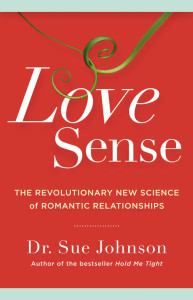 Dr. Sue Johnson, creator of emotionally focused therapy and bestselling author of Hold Me Tight: Seven Conversations for a Lifetime of Love, explores the science of love in her latest book Love Sense: The Revolutionary New Science of Romantic Relationships. In this day and age, we have the knowledge to “split the atom and soar into space,” yet we lack a clear and rigorous understanding of the instinct and connection that drives the human life. Dr. Johnson states that love is “far from being unfathomable;” it is “logical and understandable.” Dr. Johnson wrote Love Sense as a guide for finding the way to more fulfilling, lasting love.
Dr. Sue Johnson, creator of emotionally focused therapy and bestselling author of Hold Me Tight: Seven Conversations for a Lifetime of Love, explores the science of love in her latest book Love Sense: The Revolutionary New Science of Romantic Relationships. In this day and age, we have the knowledge to “split the atom and soar into space,” yet we lack a clear and rigorous understanding of the instinct and connection that drives the human life. Dr. Johnson states that love is “far from being unfathomable;” it is “logical and understandable.” Dr. Johnson wrote Love Sense as a guide for finding the way to more fulfilling, lasting love.
In part one of Love Sense, Dr. Johnson starts with an explanation of the emotional bond of love, covering John Bowlby’s attachment theory. In part two, she describes emotion, the brain and the body, weaving in years of scientific research ranging from Freud to genetic research. She normalizes the common and relatable experiences that are difficult parts of love, claiming, “Love relationships aren’t meant only to be joyrides; they’re also restorative and balancing meeting places where negative emotions are calmed and regulated.” Dr. Johnson covers the neurochemistry of love, including a detailed account of hormones and the brain. The context of the information relates to emotional bonding between parent and infant and between adult lovers.
After describing the science of love, or the physiological reactions, Dr. Johnson describes love in action in part three of Love Sense. She shares how love moves and evolves over time, stating that “relationships are not static, frozen-in-time unions; they are living, breathing organisms.” Dr. Johnson covers how bonds become unraveled and renewed. In part four, Dr. Johnson concludes with two chapters about the application of the new science on attachment and love. Providing a love story example, Dr. Johnson shows how one couple—Andre and Cleo—move from a breakup to bonding. This is a “down-to-earth story of love made possible by the love sense that is now available to us all.”
In addition to factual material, Love Sense includes experiment sections at the end of chapters, which give readers an opportunity to apply the material. Readers can utilize the scientific information presented to gain emotional understanding in the present moment. Counselors can expand their understanding of the driving force in relationships, hopefully improving their clinical effectiveness. Laypersons can read scientific information in a digestible form and apply the new information in their relationships, a task that is made easy through the book’s experiment sections. Whether the reader is a professional or not, Love Sense provides new insight on what is so “vital to our existence”—love.
Johnson, S. (2013). Love sense: The revolutionary new science of romantic relationships. New York, NY: Little, Brown.
Reviewed by: Traci P. Collins, NCC, doctoral student in counselor education at North Carolina State University and Managing Editor of The Professional Counselor.
The Professional Counselor
